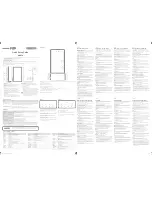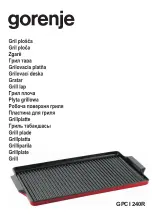
19
Troubleshooting
Troubleshooting
form a self-test (approx. 2 seconds). Afterwards,
initialisation is carried out. The LED will light up
orange and green to indicate that initialisation is
complete.
Attention!
There is a risk of explosion if the battery
is not replaced correctly. Replace only with the
same or equivalent type. Never recharge non-
rechargeable batteries. Do not throw the batteries
into a fire. Do not expose batteries to excessive
heat. Do not short-circuit batteries. Doing so will
present a risk of explosion.
Used batteries should not be disposed of with reg-
ular domestic waste! Instead, take them to your
local battery disposal point.
7
Troubleshooting
7.1
Weak battery
Provided that the voltage value permits it, the accessory
will remain ready for operation even if the battery voltage
is low. Depending on the particular load, it may be possible
to send transmissions again repeatedly, once the batteries
have been allowed a brief recovery period.
If the voltage drops too far during transmission, the corre-
sponding flashing signal will appear on the accessory (see
„7.3 Error codes and flashing sequences“ on page 20
this case, replace the empty batteries by two new batteries
(see „6 Replacing batteries“ on page 17).
7.2
Duty cycle
The wireless DHC accessories operate in the following fre-
quency bands:
• 868,000~868,600 MHz
• 869,400~869,650 MHz
In order to safeguard operation of all devices working in this
range, it is legally required to limit the transmission time of
devices. Limiting the transmission time minimizes the risk
of interference.
The ‘duty cycle’ is the maximum transmission time. It is
the ratio of the time that a device is actively transmitting
in comparison to the measurement period (1 hour), and is
expressed as a percentage of 1 hour.
If the total amount of allowed transmission time is reached,
the DHC accessory will stop transmitting until the time limit
is reached.
For example, when a device has a duty cycle limit of 1%, it
is only allowed to transmit 36 seconds in 1 hour. After this, it
will stop transmitting until the 1 hour limit is reached.
DHC accessories fully comply to this limitation and use 2
frequency bands with a duty cycle of respectively 1 % and
10%.
During normal operation of the DHC accessories, this limit
is not usually reached. However it is possible that the limit
is reached during start-up or during a fresh installation of a
Summary of Contents for homecontrols EKRSENDI1BA
Page 1: ...Installer and user reference guide Daikin Home Controls Room Sensor EKRSENDI1BA ...
Page 2: ...1 A B C D ...
Page 3: ...2 3 ...
Page 4: ...4 5 E F G H G H ...
Page 5: ...7 6 I ...
Page 27: ...omestic osed of equip cal and d exclu de any st deal ...
Page 28: ...Free download of the ONECTA app 4P687368 1 2022 04 ...










































